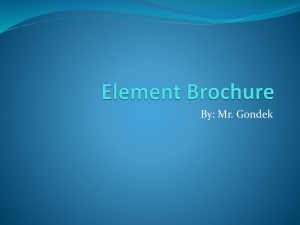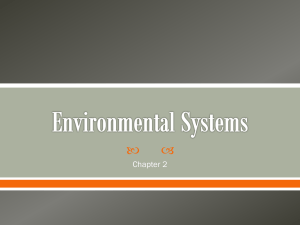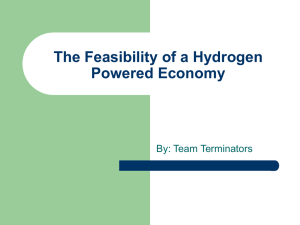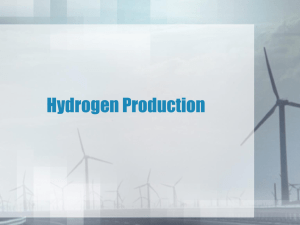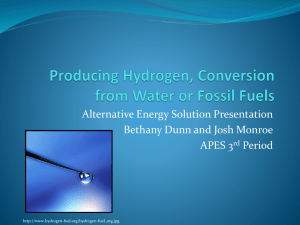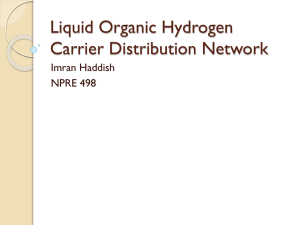Thermodynamic Evaluation of Hydrogen Absorption
advertisement
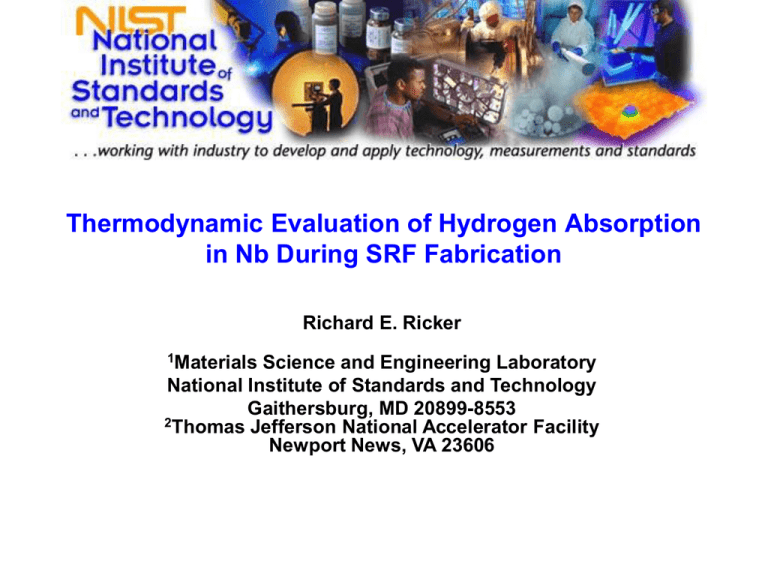
Thermodynamic Evaluation of Hydrogen Absorption in Nb During SRF Fabrication Richard E. Ricker 1Materials Science and Engineering Laboratory National Institute of Standards and Technology Gaithersburg, MD 20899-8553 2Thomas Jefferson National Accelerator Facility Newport News, VA 23606 Background Richard E. Ricker • BS, MS, N. C. State University • PhD, Rensselaer Polytechnic Institute (RPI) • Areas of expertise - Effects of environments on the properties and performance of materials in service (corrosion, mechanical properties, fracture) - Hydrogen embrittlement - Springback, dynamic modulus analysis (DMA) and internal friction Much of this presentation reviews the information published in the following paper: R. E. Ricker and G. R. Myneni, “Evaluation of the Propensity of Niobium to Absorb Hydrogen During Fabrication of SRF Cavities for Particle Accelerators,” J. Res. NIST, 115 (5) 19 pgs. Sept.-Oct. 2010. Which will be available later this month at the journals website http://nvl.nist.gov/nvl3.cfm?doc_id=89&s_id=117 Motivation Highly variable behavior with processing conditions Tensile flow curves for UHP Nb The RF performance of a cavity following different treatments at 1.7 K Q0 vs. Bp measured at 1.7 K Classic indicators of interstitials • baseline test (empty squares) • Yield points • air 4 mos, 1 Atm H2 for 11 h (red), • Serrations or PLCs • 2xs H2 at 1 atm at 120 °C for 12 h (blue), (Portevin-Le Chatelier Effect) • 600 °C for 10 h in UHV (green) • Variations in strength and ductility for • 120 °C for 12 h in UHV (empty same grain size and composition diamonds). Tensile Flow Cures The Influence of Processing Conditions on Deformation and Fracture Classic hardening by interstitial solutes is observed: (1) yield points, (2) serrations, (3) shortened easy glide (stage 2) region, and (4) Reduced ductility at lower strain rates. Hypothesis Variations in plastic flow and performance are due to hydrogen absorption Hydrogen is absorbed into niobium during SRF processing and influences performance during fabrication and service. Evaluation of the Hypothesis +/- H testing H measurement as a function of proc. Q as a function of [H] content Missing Piece Scientifically sound explanation for why the hypothesized absorption of hydrogen should occur in SRF processing environments Evaluation of relative tendency to absorb hydrogen from the different processing environments Chemical and Electrochemical Thermodynamics This analysis will use the standard principles of chemical thermodynamics [P roducts] K [Reactants] Reaction Constant (K) Electrode potential (E) and work (∆G) E G/nF Thermodynamic reference reaction and reference electrodes The fact that the surface coverage created by 1 barr of hydrogen creates a reference electrode potential of 0 by definition in a pH=0 solution relates chemical potentials (∆G/mol) of reactions to hydrogen activities. Fugacity is the hydrogen activity expressed in terms of pressure and is not a real pressure. This creates a direct numeric link between chemical potentials and hydrogen surface activity or “fugacity.” The equilibrium hydrogen fugacity will be used as a measure of the relative propensity of different processing environments to cause hydrogen absorption. Scenario Postulated sequence of events Nb metal covered with a passivating film of Nb2O5 is placed into the processing environment. The passivating film is reduced or breached either locally or generally by mechanical (abrasion), physical (permeation), or chemical means. This brings the processing environment at the bulk composition into direct physical contact with Nb metal allowing reactions of the type below to proceed xNb(s) yH2O NbxOy (s) 2yH 2ye This results in the build up of negative charge on the surface of the metal that stimulates the reduction of the adsorbed H ions 2H 2e H2 (g) A steady state process of film breakdown, hydrogen ion discharge, and passive film repair results and continues during processing. hydrogen absorbed will depend on the kinetics of this steady state The actual quantity of process, but the maximum possible thermodynamic driving force for absorption or hydrogen activity on the surface will be that generated when the unaltered processing environment initially contacts freshly exposed bare metal. Since this quantity can be calculated from chemical thermodynamics, it will be calculated as a fugacity and used as a relative measure of the propensity for hydrogen absorption. Hydrogen evolution reaction on a metal surface Principles of Hydrogen Ion Discharge and Absorption 1. The activity of the absorbed hydrogen is not limited to the external pressure. Since the hydrogen is generated by tunneling electrons from the metal into the adsorbed hydrogen ions of the adsorbed molecules, the activity of the adsorbed hydrogen will be determined by the kinetics of this process compared to the rate that this population is reduced by mass transport and the recombination of adsorbed hydrogen ions to form adsorbed molecules of diatomic hydrogen gas. The adsorbed molecules of hydrogen must then surface diffuse and combine to nucleate the gas bubbles. 2. Hydrogen can be absorbed even when H2(g) bubbles are not observed. 3. In fact, changes to the environment that promote H2(g) bubbling tend to reduce NOT increase H absorption. This is because they reduce the activity of hydrogen on the surface required to nucleate the bubbles. 4. Hydrogen adsorption comes first. Examination of the diagram on the proceeding page indicates that water molecules tend to adsorb on the metal with the positive hydrogen ions down due to the negative charge of the metal. Since electron tunneling into these adsorbed ions do not required mass transport of ions, it will occur very rapidly enabling the system to approach the thermodynamic limiting fugacity calculated here using equilibrium thermodynamics. Processing Environments Hydrogen Equilibrium Fugacities 1. Dilute Aqueous Solutions, [H2O]≈1 xNb(s) yH 2O(l) Nb xOy (s) yH 2 (g) logPeq(H 2 ) G yRT ln(10) logPeq (H 2 ) 20(barr) 2. Reactions with Water Vapor, [H2O]≈relative humidity (RH) logPeq(H 2 ) G log(RH ) yRT ln(10) logPeq (H 2 ) 16(barr) 3. Solvents and cutting fluids (same as water vapor) Processing Environments Hydrogen Equilibrium Fugacities (cont.) 4. Concentrated Mineral Acids (BCP), [H+]≈? Approach 1: Assume acid (HF) dictates H Fugacity 2Nb(s)10HF 2NbF5 5H 2 (g) The [H] activity is then. G log[P(H 2 )] 2log[HF] 5RT ln(10) log[ P(H 2 )] 16(barr ) Approach 2: Assume residual water concentration determines H Fugacity logPeq (H 2 ) 19.9(barr) Processing Environments Hydrogen Equilibrium Fugacities (cont.) 5. Electro-polishing Electro-polishing transfers the hydrogen evolution reaction to the auxiliary electrode. The extent of this transfer will depend on cell voltages, electrode geometry, etc. Using representative values for Tafel constants calculations indicates that the hydrogen fugacity may be as low as 1 barr depending on cell geometry. Nb-H Phase Diagram The hydrogen fugacities calculated for bare exposed Nb surface during processing exceed those required to nucleate the observed hydrides. Literature Examples of H uptake found in the literature Hydrogen content in an Al alloy as a function of abrasion time in an aqueous slurry. (S. W. Ciraldi, PhD Univ. of Ill, 1980) Permeation of water through a passive film to generate H2 and blister an Al alloy observed in a transmission electron microscope. (Scamans and Tuck, EnvironmentallySensitive Fracture of Engineering Materials, TMS, 1979, p464) Silver Bridge Collapse, Ohio River, Dec. 15, 1967 46 dead Hydrogen absorption in high strength steel fitting. Conclusions 1. The calculated H fugacity driving absorption was absurdly high in all cases except for the electro-polishing solution and potentials. 2. Therefore, H uptake by Nb during processing is virtually unavoidable if water is present when processing conditions break the passivating surface film. 3. Residual water in an H2(g) environment may have a greater influence on the surface activity of hydrogen driving absorption than the H2(g) pressure. 4. Understanding the tendency of Nb to absorb hydrogen and managing the passivating surface layers should enable the consistent fabrication of optimal performing cavities
